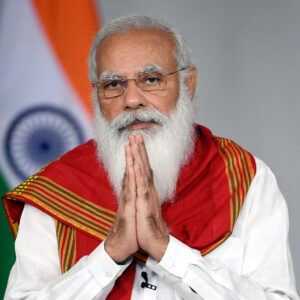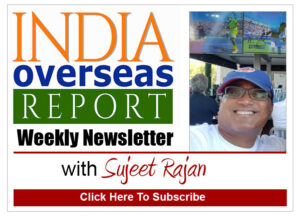Western media’s shameful, biased attack on PM Modi, India should stop
By Sujeet Rajan
Cross Talk

They are equally drawn to the squalor, stench and poverty of the country’s rural and urban underprivileged masses. Their focus has increased of late on deprivation and helplessness of poor Indians in the face of the pandemic; the inadequacies of a country caught unawares by a pandemic which has ravaged countries globally, including the United States.
Some of the major publications in the United States have force fed their readers for decades an image of malnourished, abysmal, destitute Indians.
Yet, the Western media’s biggest target of all in recent years, from which they seem to derive the biggest mileage, go about it with relentless abandon, is unfair targeting of India by castigating time and again Prime Minister Narendra Modi.
What the likes of The New York Times, The Washington Post, Time magazine and The Atlantic continue to do through their biased and mostly blatantly poor reportage of India is in more ways than one discriminatory. It’s likely leading to racism or perceived racism against India and the Indian diaspora living in the West.
The reporters or the horde of left and far left leaning academics these publications get to write disparagingly about India, don’t seem to care two hoots about development issues in India or the progress the country has made in the 21st century. There is little mention of progress, if at all.
Take the coverage by Mujib Mashal, an Afghanistan-born journalist recently hired to be stationed in the New Delhi Bureau, by The New York Times.
In an article last week, headlined, ‘In a Crisis, India’s Modi Could Always Change the Narrative. Then Came Covid’, Mashal has his work cut out for him by his bosses sitting in New York: write a piece to viciously target Modi for a global pandemic which took India off guard.
Mashal’s journalism smacks more of Indophobia, bias against Modi, than any meaningful reporting from a foreign country. What one can glean at best is that the rambling, confused piece by Mashal is written more like a rookie opposition party activist in India, who cannot help express his admiration for Modi too.
Mashal couldn’t completely shut out the real facts of the situation in India, writing at one point, after criticizing Modi for his handling of the pandemic: “Mr. Modi’s approval rating is still above 60 percent, according to one poll.”
What Mashal doesn’t reveal that the poll he refers to, the Morning Consult, shows that as of June 8, 2021, Modi is the most popular elected leader in the world of a major democracy, despite the devastating effect of Covid, which has destroyed the economic fabric of India at present, like many other countries.
In comparison, the Morning Consult poll shows the approval rate for President Biden – despite his impressive vaccination drive and generous dropping of cash into the pockets of most Americans – is at 52%; Justin Trudeau at 45%; Boris Johnson at 46%; Emmanuel Macron at an abysmal 35%; Angela Merkel at 53%; and Scott Morrison at 53%.
Mashal’s piece swings between Modi’s past – from “fanning religious violence” to banned from entering the United States – to his growing persona as India’s development champion.
Mashal writes: “In the face of crisis, Mr. Modi has displayed a talent of inventing a new narrative and switching personas, including combative national champion, digital leader and spiritual guide. At times he could seem deeply relatable, at others above it all. And he had what the opposition lacked: an ability to take his message viral.”
To be fair to him, Mashal perhaps is still getting used to reporting from a democracy, unlike where he grew up and did most of his reporting, Afghanistan – the corrupt, Islamic republic most known for exporting global terrorism, and where pandemic or no pandemic, bombing of innocent children and women by terrorists are a common phenomenon, and a part and parcel of daily life.
One can only wonder at the quality of fair and balanced reportage of India by The New York Times when apart from Mashal, they also inducted last year into their New Delhi Bureau, Sameer Yasir, a Kashmiri-born journalist who, according to his official bio, has covered “the rise of nationalism in India.” It may not come as a surprise to many that Yasir has incessantly written on disgruntlement by some people in Kashmir after the revocation of Article 370 by India, which stripped Kashmir of special status and made it a normal part of India.
What the New York Times lacks, or they refuse to do, is to hire quality reporters like John Stackhouse of The Globe and Mail, who in the nineties covered India’s potential in rural communities and the country’s progress, as the Canadian publication’s first development reporter.
The question to be asked is: can you really expect reporters like Mashal and Yasir to write positively too about India and Modi, when it is deserving?
The Atlantic is proving to be, of late, India’s biggest media critic.
Jonah Blank, the author of ‘Arrow of the Blue-Skinned God’ and ‘Mullahs on the Mainframe’, in a piece last week headlined ‘India’s Democracy Is the World’s Problem’, feigns alarm at what he perceives as fading democracy in India (of course, he totally ignores the recent peaceful elections held in several states in India).
“Modi’s response to the pandemic has swung from oppressive lockdown to maskless political rallies and the encouragement of a super-spreader Hindu pilgrimage with 9 million attendees. A political system in which the government could be held accountable might have yielded a different outcome,” Blank reckons.
Blank concludes his sermonizing – with no facts to support his arguments and ignores the fact that election rallies were held in the US too before and during the Presidential elections – with the notion: “If the system fails in India, it can certainly fail closer to home.”
Last week, another piece in The Atlantic, by the New Delhi-based journalist Snigdha Poonam, attacked India and Modi, with the headline ‘How Dissent Dies.’
The piece, focused on protests last year in Delhi on the revocation of the Citizenship Amendment Act, makes a categorical statement, “Modi’s seven years in power mark the worst period for Indian democracy since the 1970s, when Indira Gandhi declared a state of emergency, suspending all civil liberties and curtailing the press.”
Unlike Blank, Poonam totally ignores the emanation and fostering of domestic and cross-border terrorism in Punjab and Kashmir that led successive governments in India to initiate stern action to keep India intact; not be split into states declaring themselves independent.
It’s not that India has not tried to stymie this unfair coverage of India. Foreign Minister S. Jaishankar has termed the Western media criticism as from “a set of self-appointed custodians of the world, who find it very difficult to stomach that somebody in India is not looking for their approval, is not willing to play the game they want to be played.”
Poonam quotes Milan Vaishnav, a senior fellow at the Carnegie Endowment for International Peace in Washington, D.C, saying:
“The fact of the matter is that the United States, and much of the West, has made a long-term strategic bet that India will provide a democratic counterweight to an authoritarian China,” adding, India “possesses many of the trappings of electoral democracy, while democracy between elections atrophies.”

Of course, the article fails to mention the fact that Vaishnav recently had predicted that despite the ravages of the pandemic, Modi will win the general elections again, come 2024.
Another rambling and preposterous piece in The Atlantic, last week, is by Aatish Taseer, titled ‘The war on Bollywood’. Taseer is the man who wrote the controversial cover story for Time magazine, in May 2019, entitled, ‘India’s divider in chief’, where he criticized Modi. Later that year, Taseer’s Overseas Citizenship of India status was revoked by India on the grounds that he concealed information that his father was of Pakistani origin.
Taseer’s latest piece, belying the glamorous headline, instead focuses on lawsuits against two shows on Amazon and Netflix, ‘Tandav’ and Bombay Begums’. Somebody needs to tell him politely that TV shows from India, even if they feature actors who have acted in Hindi films, cannot be categorized as ‘Bollywood’.
However, what is most ludicrous, is how Taseer, who calls London and New York as home, deviates to, almost in a state of stupor, between his venom for Modi, to reminiscing the time in 2013 when he was dating a male director in Bombay, to name dropping the likes of KJo, the Khans, and Amitabh Bachchan, and Kangana Ranaut.
Then suddenly as if he lurched back to the realization that he was being paid by the Atlantic for a reason, he starts spewing some more against Modi: “There is a heartbreaking inevitability to the confrontation between Bollywood and Modi’s BJP. Modi does not view India as a composite culture, to which Hindus, Muslims, Sikhs, and Christians have all contributed, but rather as an essentially Hindu entity whose destiny lies in bringing about a Hindu cultural renaissance.”
He then comes up with this confounding statement: “It’s hard to know whether Bollywood will emerge with its character intact,” before mercifully the incoherent piece comes to an end.
The virulent or at times sly diatribe against India is a position taken often by The Washington Post, especially by using Indian-origin academics in the United States.
Amrita Basu, the Paino Professor of Political Science and Sexuality, Women’s and Gender Studies at Amherst College and author of ‘Violent Conjunctures in Democratic India’, in a piece headlined, ‘Many right-wing populists strut their manliness. Why does India’s Modi stress his softer side?’ theorizes (or is it fantasizes) that “Modi depicts himself him not as a man’s man, but as a modern saint.”
She writes, drawing a bizarre connection to Modi’s appeal to the masses, “Unlike these populist strongmen, Modi has sometimes venerated femininity and women, drawing on his interpretation of Hindu values. Modi’s leadership style involves displaying feminine-identified traits such as selflessness, humility, and devotion. After his 2019 election campaign, he draped himself in a saffron robe and meditated overnight in a cave. He has made it clear that he prefers silence to bragging and that he is a vegetarian, teetotaler, celibate, and ascetic.”
Now, here is my problem: is Basu trying to eulogize Modi or laying the argument to criticize him, which she does do, later, much later.
But before she starts her flagellation, she again shows some admiration for Modi: “Sporting a flowing beard and long hair, Modi looks more like a sage than a politician. While other populists make homophobia and sexism into a selling point, Modi supports certain trans rights, albeit specifically for the Hindu trans community, and Muslim women’s rights, as a way to promote Hindu superiority over Muslims. He has depicted himself as favoring women’s empowerment, and condemned violence against women, female feticide and discrimination against girls.”
She also lauds Modi for opposition to untouchability, like Gandhi; that his “public appeal draws on Gandhi’s fusion of asceticism, religious and moral power, and self-sacrifice”, and his popular “Swacch Bharat” campaign, started in 2014.
Now here comes the jaw-dropping analysis by Basu after all these laudatory words for Modi: “Modi faces new difficulties. His popularity has been dented by public anger at the enormous wave of coronavirus deaths. Modi has been characteristically and purposefully silent. Both he and his populist challengers will combine masculine and feminine imagery to justify policies, appeal to followers, and attract new supporters, in ways that will surprise those whose understanding of populism begins and ends with Trump.”
Frankly, there are at times, I’m disgusted and appalled by the Western media’s coverage of India. And there are times when I’m dumbfounded by the distorted analysis – all in the name of desperately attacking Modi – that shows up almost daily.
India has spoken up about this unfair coverage of India, in the US.
Earlier this year, The Indian Embassy in Washington DC accused Kapil Komireddi of “targeting” Modi through his essay in The Washington Post. The essay, said a statement, was “a bitter polemic targeting the prime minister of India. Its depiction of the people of India as powerless and malleable was downright insulting to them.”
The Embassy added, “If a society judges its leader positively and his political colleagues speak well of him, that should hardly be a cause for concern.”
The Hindustan Times reported the Indian Embassy last month reached out to Indians studying in the US in an effort to help counter the purported “biased and negative narrative” against the country in the international media amid a devastating second wave of Covid-19 infections.
Discrimination and Indophobia against India is nothing new, though, in the US.
White supremacy reared up its head against the Indian community as early as in September, 1907, in Bellingham, Washington, when a mob of 400-500 white men, predominantly members of the Asiatic Exclusion League, attacked the homes of mostly Sikhs, who were labelled as Hindus, notes Wikipedia.
Vamsee Juluri, author and Professor of Media Studies at the University of San Francisco, identifies Indophobia in certain sections of the US media as part of a racist postcolonial/neocolonial discourse used to attack and defame India and encourage racial prejudice against Indian Americans, particularly in light of India’s recent economic progress, which some ‘old-school’ colonialists find to be incompatible with their Clash of Civilizations world view.
One of the acute problems of motived reporting of India – and several European outlets too are guilty of this – is that in the course of time, it invariably raises discrimination against the Indian diaspora too.
An independent survey done by Sumitra Badrinathan, Devesh Kapur – the Starr Foundation Professor of South Asian Studies and director of Asia Programs at the Johns Hopkins School of Advanced International Studies, Jonathan Kay and Milan Vaishnav, reported in The Washington Post, last week, reveals widespread perceptions of discrimination against Indian Americans on multiple grounds.
The analysis noted the abuse and violent attacks in the New York-New Jersey region by such groups as the “Dotbusters” against the Indian and South Asian community, in the 1980s. These attacks culminated in the brutal 1987 murder of a Citibank executive. It also delves into the aftermath of the September 11, 2001, terrorist attacks, when several Indian Americans were victims of violent hate crimes and xenophobic rhetoric, with the Sikh community targeted in particular.
The survey found that 31 percent of Indian Americans believe that discrimination against people of Indian origin is a major problem in the United States – while 53 percent think it’s a minor problem. One in two Indian Americans reports being subjected to some form of discrimination over the previous 12 months. Indian Americans, born in the US, too, complained of discrimination.
Discrimination on the basis of one’s skin color is followed by discrimination due to one’s gender, religion or Indian heritage, in the survey. A small fraction of all respondents report having encountered discrimination because of their caste identity.
Importantly, when asked about discrimination on the basis of country of origin or skin color, respondents overwhelmingly blame non-Indians, the Post analysis noted.
While respondents suggest Indians hold somewhat greater responsibility for engaging in religious or gender discrimination against other Indians, here, too, they point mainly to non-Indians or a combination of Indians and non-Indians as primary sources of discrimination.
The survey should make the major Western media publications ponder on what it is they are really achieving by negative coverage of India: it is likely fostering not only discrimination but also contempt for the Indian American diaspora and their subsequent generations.
It’s time the Western media stopped this crude, classless, and shameful attack on Modi and India.
(Sujeet Rajan is Editor-in-Chief of www.indiaoverseasreport.com Write to him: editor@indiaoverseasreport.com Follow him on Twitter @SujeetRajan1)

